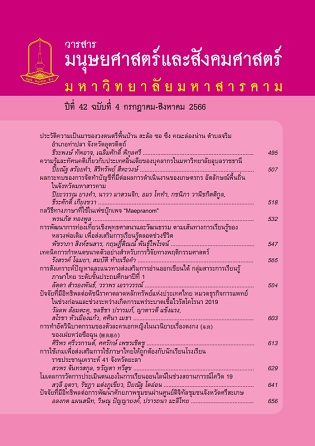โมเดลการวัดการประเมินตนเองในการเรียนออนไลน์ในช่วงสถานการณ์โควิด 19
Main Article Content
บทคัดย่อ
การวิจัยนี้มีวัตถุประสงค์เพื่อศึกษาปัจจัยที่เกี่ยวข้องกับการประเมินตนเองในการเรียนออนไลน์ของนักศึกษาในระหว่างการระบาดของโควิด 19 และเพื่อวิเคราะห์องค์ประกอบเชิงยืนยันปัจจัยชี้วัดการประเมินตนเองในการเรียนออนไลน์ กลุ่มเป้าหมายในการศึกษาคือ นักศึกษามหาวิทยาลัยกาฬสินธุ์ที่กำลังเรียนออนไลน์จำ นวน 171 คน ด้วยแบบสอบถามชนิดตอบด้วยตนเอง การศึกษาในงานวิจัยนี้ใช้การวิเคราะห์องค์ประกอบเชิงสำ รวจ และองค์ประกอบเชิงยืนยัน ผลการศึกษาพบว่า 22 ตัวแปรเชิงสำรวจและ 6 ปัจจัยชี้วัดการประเมินตนเองในการเรียนออนไลน์ในช่วงสถานการณ์โควิด 19 สามารถสร้างองค์ประกอบเชิงยืนยันได้ ประกอบด้วย การประเมินตนเอง กลยุทธ์ในการจัดการทำงาน การตั้งเป้าหมายสิ่งแวดล้อม การบริหารจัดการเวลา และความช่วยเหลือ ประโยชน์ที่ได้สร้างนำ ไปสร้างเป็นแบบประเมินตนเองในการเรียนออนไลน์ของนักศึกษาในช่วงสถานการณ์แพร่ระบาดของโรคโควิด-19 ได้
Article Details
เอกสารอ้างอิง
กรมควบคุมโรค. (2566). สถานการณ์ผู้ติดเชื้อ COVID-19. https://covid19.ddc.moph.go.th/
เกตุม สระบุรินทร์, ศราวุฒิ แย้มดี, และ ณัฏฐวัฒน์ ไชยโพธิ (2559). ทัศนคติและพฤติกรรมของนักเรียนต่อการใช้บทเรียนออนไลน์ด้วยโปรแกรม Moodle กรณีศึกษาโรงเรียนมัธยมศึกษาแห่งหนึ่งในกรุงเทพมหานคร [มหาวิทยาลัยราชภัฏสวนสุนันทา, กรุงเทพมหานคร]
จิรากานต์ อ่อนซาผิว และสุชาดา นันนทะไชย. (2564). ปัญหาและความต้องการของการจัดการเรียนรู้ในช่วงสถานการณ์โควิด 19 โรงเรียนวัดด่านสำ โรง สำ นักงานเขตพื้นที่การศึกษาประถมศึกษาสมุทรปราการเขต 1. Journal of Modern Learning Development, 6 (4).
ธนพรรณ ทรัพย์ธนาดล. (2554). ปัจจัยที่มีผลกระทบต่อการจัดการเรียนการสอนบทเรียนออนไลน์ ของมหาวิทยาลัยราชภัฎนครราชสีมา. Veridian E-Journal SU, 4 (1).
พระมหาเมธี จนทว์โส, พระครูวิโชติสิกขกิจ, & ดวงฤทัย เอี่ยมพล. (2565). ปัญหาการเรียนออนไลน์.วารสารวิชาการแสงอีสาน มหาวิทยาลัยมหามกุฏราชวิทยาลัย วิทยาเขตอีสาน, 19 (1).
มาลีวัล เลิศสาครศิริ, จุรีย์ นฤมิตเลิศ, & กิติยา สมุทรประดิษฐ์. (2564). ปัจจัยที่มีผลต่อพฤติกรรมการเรียนผ่านระบบออนไลน์ของนักศึกษาวิทยาลัยเซนต์หลุยส์ จากสถานการณ์โควิด-19. วารสารสุขภาพับการจัดการสุขภาพ, 7 (1).
วิทยา วาโย, อภิรดี เจริญนุกูล, ฉัตรสุดา กานกายันต์, & จรรยา คนใหญ่. (2563). การเรียนการสอนแบบออนไลน์ภายใต้สถานการณ์แพร่ระบาดของไวรัส COVID-19: แนวคิดและการประยุกต์ใช้จัดการเรียนการสอน. วารสารศูนย์อนามัยที่ 9, 14 (34), 34.
วิทัศน์ ฝักเจริญผล, กนิษฐา เชาว์วัฒนกุล, พินดา วราสุนันท์, กุลธิดา นุกูลธรรม, สุมิตร สุวรรณ, สินีนุช สุวรรณาภิชาติ, กิติศาอร เหล่าเหมณี. (2563). ความพร้อมในการจัดการเรียนการสอนออนไลน์ภายใต้สถานการณ์ระบาดไวรัส Covid-19 Readiness to Implement Online Learning Management under the Covid-19 Pandemics. วารสารศาสตร์การศึกษาและการพัฒนามนุษย์, 44 (1), 44-61.
Alibak, M., Talebi, H., Neshat-Doost, & Hamid-Taher. (2019). Development and validation of a test anxiety inventory for online learning students. Journal of Educators Online, 16, 16.
Barnard, L., Lan, W. Y., To, Y. M., Paton, V. O., & Lai, S.-L. (2009). Measuring self-regulation in online and blended learning environments. The Internet and Higher Education, 12 (1), 1-6. https://doi.org/https://doi.org/10.1016/j.iheduc.2008.10.005
Cerny, B. A., & Kaiser, H. F. (1977). A study of a measure of sampling adequacy for factor-analytic correlation matrices. Multivariate Behav Res, 12 (1), 43-47. https://doi.org/10.1207/ s15327906mbr1201_3
Hooper, J. C. & Mullen, M. (2008). Structural equation modelling: Guidelines for determining model fit. Electronic Journal of Business Research Methods, 53-61.
Deb, S., & Ali Ahmed, M. (2018). Determining the service quality of the city bus service based on users’ perceptions and expectations. Travel Behaviour and Society, 12, 1-10. https://doi.org/https://doi.org/10.1016/j.tbs.2018.02.008
Dong, E., Du, H., & Gardner, L. (2020). An interactive web-based dashboard to track COVID-19 in real time. Lancet Infect Dis, 20 (5), 533-534. https://doi.org/10.1016/s1473-3099 (20) 30120-1
Fornell, C., & Larcker, D. F. (1981). Evaluating structural equation models with unobservable variables and measurement error. Journal of Marketing Research, 18 (1), 39-50.https://doi.org/10.2307/3151312
Golob, T. F. (2003). Structural equation modeling for travel behavior research. Transportation Research Part B: Methodological, 37 (1), 1-25. https://doi.org/https://doi.org/ 10.1016/S0191-2615 (01) 00046-7
Hair, J. F. B., W.C. Babin, B.J. (2010). Multivariate data analysis: A global perspective. Pearson Education. https://books.google.co.th/books?id=SLRPLgAACAAJ
Hu, L. t., & Bentler, P. M. (1999). Cutoff criteria for fit indexes in covariance structure analysis:Conventional criteria versus new alternatives. Structural Equation Modeling: A
Multidisciplinary Journal, 6 (1), 1-55. https://doi.org/10.1080/10705519909540118 Jomnonkwao, S., Sangphong, O., Khampirat, B., Siridhara, S., & Ratanavaraha, V. (2016). Public transport promotion policy on campus: evidence from Suranaree University in
Thailand. Public Transport, 8 (2), 185-203. https://doi.org/10.1007/s12469-016-0122-2
Khampirat, B. (2012). Structural equation modeling. Institute of Social Technology (IST) Suranaree University of Technology.
Kline, R. B. (2011). Principles and practice of structural equation modeling. Guilford Press.
Lai, W.-T., & Chen, C.-F. (2011). Behavioral intentions of public transit passengers—The roles of service quality, perceived value, satisfaction and involvement. Transport Policy, 18 (2), 318-325. https://doi.org/https://doi.org/10.1016/j.tranpol.2010.09.003
Loehlin, J. C. (1998). Latent variable models: An introduction to factor, path, and structural analysis. Lawrence Erlbaum Associates.
Maheshwari, G. (2021). Factors affecting students’ intentions to undertake online learning: an empirical study in Vietnam. Education and Information Technologies, 26 (6), 6629-6649. https://doi.org/10.1007/s10639-021-10465-8
Nunnally, J. C. (1978). Psychometric theory. McGraw-Hill. https://books.google.co.th /books?id=WE59AAAAMAAJ
Pham, T. T. T., Le, H. A., & Do, D. T. (2021). The factors affecting students’ online learning outcomes during the COVID-19 pandemic: A bayesian exploratory factor analysis.
Education Research International, 2021, 2669098. https://doi.org/10.1155/2021/2669098 Pintrich, P. R., Smith, D. A. F., Garcia, T., & McKeachie, W. J. (1993). Reliability and predictive validity of the motivated strategies for learning questionnaire (Mslq).
Educational and Psychological Measurement, 53 (3), 801-813. https://doi.org/10.1177/ 0013164493053003024
Podsakoff, P. M., MacKenzie, S. B., Lee, J. Y., & Podsakoff, N. P. (2003). Common method biases in behavioral research: a critical review of the literature and recommended remedies. J Appl Psychol, 88 (5), 879-903. https://doi.org/10.1037/0021-9010.88.5.879
Reason, J., Manstead, A., Stradling, S., Baxter, J., & Campbell, K. (1990). Errors and violations on the roads: a real distinction?. Ergonomics, 33 (10-11), 1315-1332. https://doi.org/10.1080/00140139008925335
Yu, Q. (2022). Factors influencing online learning satisfaction. Frontiers in Psychology, 13.https://doi.org/10.3389/fpsyg.2022.852360

